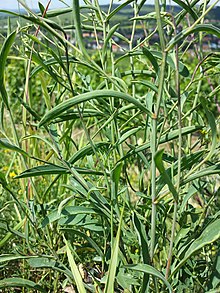Sickle-leaved rabbit ear
| Sickle-leaved rabbit ear | ||||||||||||
|---|---|---|---|---|---|---|---|---|---|---|---|---|

Sickle-leaved rabbit's ear ( Bupleurum falcatum ) |
||||||||||||
| Systematics | ||||||||||||
|
||||||||||||
| Scientific name | ||||||||||||
| Bupleurum falcatum | ||||||||||||
| L. |

The sickle-leaved hare's ear ( Bupleurum falcatum ), also known as sickle-hare's ear , salvation of the world or wound herb , is an umbelliferous plant (Apiaceae) that is found scattered in Central Europe .
Appearance
The perennial herbaceous plant is about 60 to 150 cm high and is a hemicryptophyte . The stem is usually more or less bent back and forth and mostly branched in the upper part. The leaves are often curved sickle-shaped, the lower elliptical or oblong in shape and narrowed into the petiole. The upper ones are lanceolate and narrowed at both ends.
The umbels are 6 to 15-pointed. The döldchen have five bracts of ovoid shape and are not or only slightly longer than the fruit stalks. The bracts and bracts are lanceolate in shape and often pointy. The crown is colored golden yellow.
The fruit is smooth when young; when ripe it has wing-like protruding ribs. It has a length of about 3.5 to 4 mm and is egg-shaped.
It blooms from July to October.
The number of chromosomes is 2n = 16.
ecology
The sickle-leaved rabbit's ear is a perennial stem plant, a hemicryptophyte and a deep-rooted plant. It is rooted up to 130 centimeters deep.
The flowers are golden yellow, "nectar-bearing disc flowers". Pollinators are flies , hymenoptera and beetles . Flowering time is from July to October.
The small split fruits are double achenes; they spread as wind and animal spreaders, and it is likely that they spread randomly through grazing animals.
Location claims and distribution
Bupleurum falcatum grows in dry bush and dry forest communities. It prefers moderately dry, poor, mostly lime-rich, deep to medium-sized, loose, moderately acidic to mildly humic loam or loess soils. In Central Europe it is a character species of the Geranion sanguinei association, but also occurs in societies of the Convolvulo-Agropyrion or Erico-Pinion associations.
The sickle-leaved rabbit's ear occurs in southern Europe, in central and eastern Europe and in Great Britain as well as in Turkey, in Egypt and in the Caucasus region. It is a Eurasian-continental-sub-Mediterranean floral element . In Austria it is very common in the Pannonian region , otherwise only rarely to be found. In Switzerland, the species occurs generally absent-minded.
Bupleurum falcatum is scattered to widespread in places in the central part of Germany. In addition, it is rarely and often inconsistent to find.
Related species
A related species is the long-leaved rabbit ear .
Subspecies
The following subspecies can be distinguished:
- Bupleurum falcatum L. subsp. falcatum
- Bupleurum falcatum subsp. cernuum (Ten.) Arcang. : Occurs in Southern Europe, Eastern Europe and the Middle East.
- Bupleurum falcatum subsp. corsicum (Coss. & Kralik) Rouy & EG Camus : Occurs in Corsica and possibly also in Sardinia.
- Bupleurum falcatum subsp. dilatatum Schur : occurs in Slovakia, Romania and Croatia.
- Bupleurum falcatum subsp. persicum (Boiss.) Koso-Pol. : Occurs in Turkey.
- Bupleurum falcatum subsp. polyphyllum (Ledeb.) H. Wolff : Occurs in the Middle East.
literature
- Henning Haeupler , Thomas Muer: picture atlas of the fern and flowering plants of Germany (= the fern and flowering plants of Germany. Volume 2). Published by the Federal Agency for Nature Conservation. Ulmer, Stuttgart 2000, ISBN 3-8001-3364-4 .
- Sebald, Seybold, Philippi: The fern and flowering plants of Baden-Württemberg , Ulmer Verlag, Stuttgart, 1990, ISBN 3-8001-3314-8
- Wolfgang Adler, Karl Oswald, Raimund Fischer: Excursion flora of Austria. Ed .: Manfred A. Fischer . Ulmer, Stuttgart / Vienna 1994, ISBN 3-8001-3461-6 .
- August Binz , Christian Heitz: School and excursion flora for Switzerland , Schwabe & Co. AG, Basel, 1986, ISBN 3-7965-0832-4
- Erich Oberdorfer : Plant-sociological excursion flora , Ulmer Verlag, Stuttgart, 1990, ISBN 3-8001-3454-3
- Ruprecht Düll , Herfried Kutzelnigg : Pocket dictionary of plants in Germany and neighboring countries. The most common Central European species in portrait. 7th, corrected and enlarged edition. Quelle & Meyer, Wiebelsheim 2011, ISBN 978-3-494-01424-1 .
Individual evidence
- ^ Georg August Pritzel , Carl Jessen : The German folk names of plants. New contribution to the German linguistic treasure. Philipp Cohen, Hannover 1882, page 70, online.
- ↑ a b c d Erich Oberdorfer : Plant-sociological excursion flora for Germany and neighboring areas . With the collaboration of Angelika Schwabe and Theo Müller. 8th, heavily revised and expanded edition. Eugen Ulmer, Stuttgart (Hohenheim) 2001, ISBN 3-8001-3131-5 , pp. 707 .
- ^ Bupleurum in the Germplasm Resources Information Network (GRIN), USDA , ARS , National Genetic Resources Program. National Germplasm Resources Laboratory, Beltsville, Maryland. Retrieved May 7, 2018.
- ↑ a b c d e f R. Hand (2011): Apiaceae. Bupleurum falcatum In: Euro + Med Plantbase - the information resource for Euro-Mediterranean plant diversity. Berlin 2011.
Web links
- Sickle-leaved rabbit ear. In: FloraWeb.de.
- Profile and distribution map for Bavaria . In: Botanical Information Hub of Bavaria .
- Sickle-leaved rabbit ear . In: BiolFlor, the database of biological-ecological characteristics of the flora of Germany.
- Bupleurum falcatum L. s. l. In: Info Flora , the national data and information center for Swiss flora . Retrieved January 3, 2016.
- Bupleurum falcatum subsp. cernuum (Ten.) Arcang. In: Info Flora , the national data and information center for Swiss flora . Retrieved January 3, 2016.
